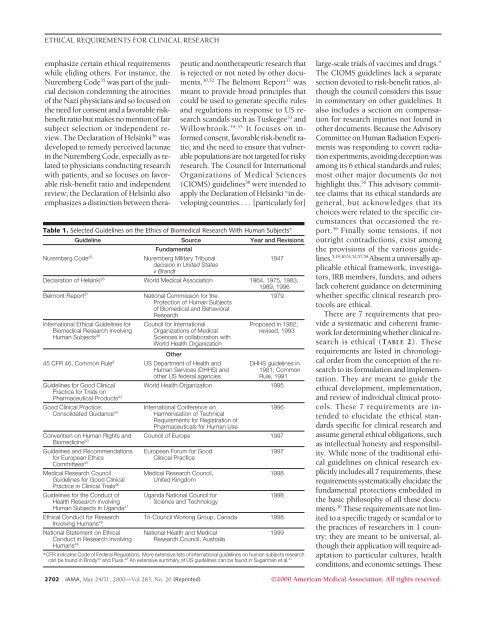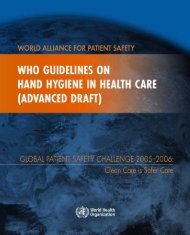What Makes Clinical Research Ethical? - Forum of Ethics Review ...
What Makes Clinical Research Ethical? - Forum of Ethics Review ...
What Makes Clinical Research Ethical? - Forum of Ethics Review ...
You also want an ePaper? Increase the reach of your titles
YUMPU automatically turns print PDFs into web optimized ePapers that Google loves.
ETHICAL REQUIREMENTS FOR CLINICAL RESEARCH<br />
emphasize certain ethical requirements<br />
while eliding others. For instance, the<br />
Nuremberg Code 35 was part <strong>of</strong> the judicial<br />
decision condemning the atrocities<br />
<strong>of</strong> the Nazi physicians and so focused on<br />
the need for consent and a favorable riskbenefit<br />
ratio but makes no mention <strong>of</strong> fair<br />
subject selection or independent review.<br />
The Declaration <strong>of</strong> Helsinki 36 was<br />
developed to remedy perceived lacunae<br />
in the Nuremberg Code, especially as related<br />
to physicians conducting research<br />
with patients, and so focuses on favorable<br />
risk-benefit ratio and independent<br />
review; the Declaration <strong>of</strong> Helsinki also<br />
emphasizes a distinction between therapeutic<br />
and nontherapeutic research that<br />
is rejected or not noted by other documents.<br />
30,52 The Belmont Report 37 was<br />
meant to provide broad principles that<br />
could be used to generate specific rules<br />
and regulations in response to US research<br />
scandals such as Tuskegee 53 and<br />
Willowbrook. 54,55 It focuses on informed<br />
consent, favorable risk-benefit ratio,<br />
and the need to ensure that vulnerable<br />
populations are not targeted for risky<br />
research. The Council for International<br />
Organizations <strong>of</strong> Medical Sciences<br />
(CIOMS) guidelines 38 were intended to<br />
apply the Declaration <strong>of</strong> Helsinki “in developing<br />
countries...[particularly for]<br />
Table 1. Selected Guidelines on the <strong>Ethics</strong> <strong>of</strong> Biomedical <strong>Research</strong> With Human Subjects*<br />
Guideline Source Year and Revisions<br />
Fundamental<br />
Nuremberg Code 35<br />
Nuremberg Military Tribunal<br />
decision in United States<br />
v Brandt<br />
1947<br />
Declaration <strong>of</strong> Helsinki 36 World Medical Association 1964, 1975, 1983,<br />
1989, 1996<br />
Belmont Report 37<br />
National Commission for the<br />
Protection <strong>of</strong> Human Subjects<br />
<strong>of</strong> Biomedical and Behavioral<br />
<strong>Research</strong><br />
1979<br />
International <strong>Ethical</strong> Guidelines for<br />
Biomedical <strong>Research</strong> Involving<br />
Human Subjects 38<br />
Council for International<br />
Organizations <strong>of</strong> Medical<br />
Sciences in collaboration with<br />
World Health Organization<br />
Other<br />
45 CFR 46, Common Rule 8 US Department <strong>of</strong> Health and<br />
Human Services (DHHS) and<br />
other US federal agencies<br />
Proposed in 1982;<br />
revised, 1993<br />
DHHS guidelines in<br />
1981; Common<br />
Rule, 1991<br />
Guidelines for Good <strong>Clinical</strong> World Health Organization 1995<br />
Pharmaceutical Products 42<br />
Practice for Trials on<br />
Good <strong>Clinical</strong> Practice:<br />
Consolidated Guidance 44<br />
International Conference on<br />
Harmonisation <strong>of</strong> Technical<br />
Requirements for Registration <strong>of</strong><br />
Pharmaceuticals for Human Use<br />
1996<br />
Convention on Human Rights and Council <strong>of</strong> Europe 1997<br />
Biomedicine 43<br />
Guidelines and Recommendations<br />
for European <strong>Ethics</strong><br />
Committees 45<br />
Medical <strong>Research</strong> Council<br />
Guidelines for Good <strong>Clinical</strong><br />
Practice in <strong>Clinical</strong> Trials 46<br />
Guidelines for the Conduct <strong>of</strong><br />
Health <strong>Research</strong> Involving<br />
Human Subjects in Uganda 47<br />
European <strong>Forum</strong> for Good<br />
<strong>Clinical</strong> Practice<br />
Medical <strong>Research</strong> Council,<br />
United Kingdom<br />
Uganda National Council for<br />
Science and Technology<br />
1997<br />
1998<br />
1998<br />
<strong>Ethical</strong> Conduct for <strong>Research</strong> Tri-Council Working Group, Canada 1998<br />
Involving Humans 48<br />
National Statement on <strong>Ethical</strong><br />
Conduct in <strong>Research</strong> Involving<br />
Humans 49<br />
National Health and Medical<br />
<strong>Research</strong> Council, Australia<br />
1999<br />
*CFR indicates Code <strong>of</strong> Federal Regulations. More extensive lists <strong>of</strong> international guidelines on human subjects research<br />
can be found in Brody 39 and Fluss. 40 An extensive summary <strong>of</strong> US guidelines can be found in Sugarman et al. 41<br />
large-scale trials <strong>of</strong> vaccines and drugs.”<br />
The CIOMS guidelines lack a separate<br />
section devoted to risk-benefit ratios, although<br />
the council considers this issue<br />
in commentary on other guidelines. It<br />
also includes a section on compensation<br />
for research injuries not found in<br />
other documents. Because the Advisory<br />
Committee on Human Radiation Experiments<br />
was responding to covert radiation<br />
experiments, avoiding deception was<br />
among its 6 ethical standards and rules;<br />
most other major documents do not<br />
highlight this. 56 This advisory committee<br />
claims that its ethical standards are<br />
general, but acknowledges that its<br />
choices were related to the specific circumstances<br />
that occasioned the report.<br />
56 Finally some tensions, if not<br />
outright contradictions, exist among<br />
the provisions <strong>of</strong> the various guidelines.<br />
5,19,30,51,52,57,58 Absent a universally applicable<br />
ethical framework, investigators,<br />
IRB members, funders, and others<br />
lack coherent guidance on determining<br />
whether specific clinical research protocols<br />
are ethical.<br />
There are 7 requirements that provide<br />
a systematic and coherent framework<br />
for determining whether clinical research<br />
is ethical (TABLE 2). These<br />
requirements are listed in chronological<br />
order from the conception <strong>of</strong> the research<br />
to its formulation and implementation.<br />
They are meant to guide the<br />
ethical development, implementation,<br />
and review <strong>of</strong> individual clinical protocols.<br />
These 7 requirements are intended<br />
to elucidate the ethical standards<br />
specific for clinical research and<br />
assume general ethical obligations, such<br />
as intellectual honesty and responsibility.<br />
While none <strong>of</strong> the traditional ethical<br />
guidelines on clinical research explicitly<br />
includes all 7 requirements, these<br />
requirements systematically elucidate the<br />
fundamental protections embedded in<br />
the basic philosophy <strong>of</strong> all these documents.<br />
30 These requirements are not limited<br />
to a specific tragedy or scandal or to<br />
the practices <strong>of</strong> researchers in 1 country;<br />
they are meant to be universal, although<br />
their application will require adaptation<br />
to particular cultures, health<br />
conditions, and economic settings. These<br />
2702 JAMA, May 24/31, 2000—Vol 283, No. 20 (Reprinted) ©2000 American Medical Association. All rights reserved.
















